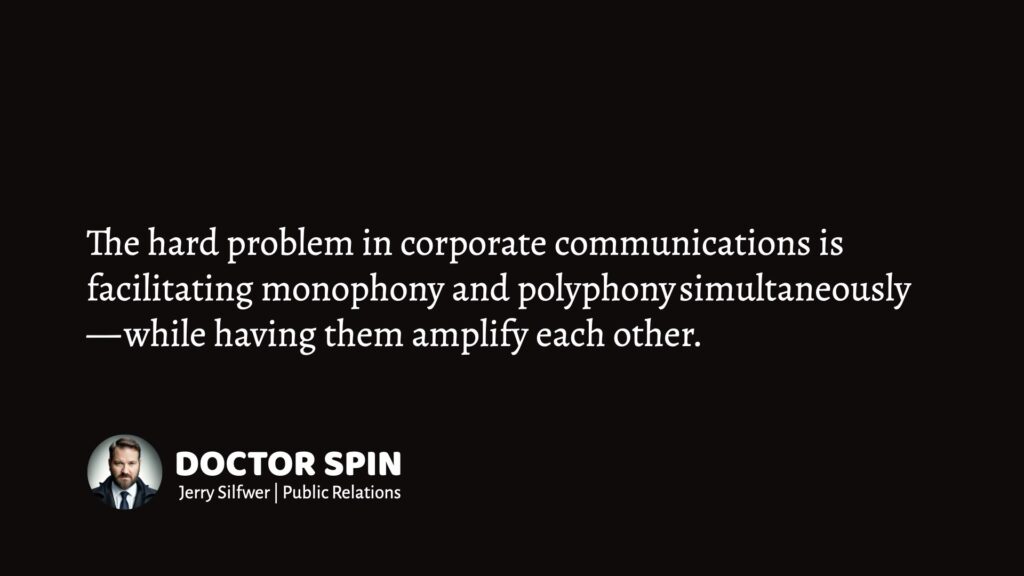How do you approach coworker advocacy?
As a communicator, getting your colleagues to understand, appreciate, and engage in corporate communication has always been a tall order. Forcing or coercing coworkers into prompted advocacy is often unethical, sometimes even illegal — and generally a bad idea regarding the actual outcomes.
Settling for just explaining the value of communication to non-communication professionals is often a vain pursuit.
There must be another way to encourage coworker advocacy.
Here we go:
The Sales Analogy
In a company, who is responsible for sales?
Of course, the “CEO” would be a perfectly reasonable answer. If a business isn’t selling, the CEO must be held accountable.
The CEO, in turn, might look to the Head of Sales. The Head of Sales must produce results and report back to the CEO. The Head of Sales might ask the Sales Department to share the burden.
But what if HR was responsible for recruiting the Head of Sales — and the whole sales team? Isn’t, then, HR responsible for sales performance as well? If HR does a lousy job recruiting, don’t they share at least a little responsibility?
What about coworkers working with order fulfilment in some capacity? The best sales pitch arguably involves a satisfied customer referring new customers. So, isn’t product and service delivery a crucial component of long-term sales success? Again, this is a perfectly reasonable assumption.
What about customer service? And what about all other support functions ensuring customer satisfaction and operational excellence? What about research- and development? Aren’t R&D critical to even having products or services worth selling?
The short answer is: Yes, they are. They all are.
Communication and coworker advocacy
The logic seems clear. In any business venture, everyone is responsible for sales. Each coworker carries the responsibility — albeit at varying degrees and in different ways! — but they all do.
Most business-minded professionals get this intuitively. No matter their role in the business, they understand that the company must make money to make payroll. Some roles struggle with proving their worth concerning the sales process, but even these people understand the importance of sales.
Now, let’s flip the narrative over to communication:
Oops.
Communication is typically one of those functions in an organisation where it’s challenging to demonstrate a direct effect on the bottom line. Still, the CEO is responsible for how the business communicates, and the Head of Communication, as is the Communication Department, is typically held accountable.
But from here, the logic often breaks down.
Communication is Everyone’s Concern
Like everything in a business relating to sales, everything a business does or says is communication. Selling is itself a highly specific and targeted form of communication. Leadership is a form of communication. Products or services are themselves communication.
In short, communication concerns everyone and everything in a business. However, many coworkers cannot see their part in the communication process.
Whereas coworkers understand that a business must make money to make payroll, many think of communications as the sole responsibility of the Communication Department. This is a slippery slope.
A few people, often near the top, might care greatly about communication, while the rest of the organisation doesn’t. This unbalance might over-emphasise monophony.
The result is top-down internal communication and conflicting messages externally. This is a recipe for quickly eroding coworker trust. This is how businesses become stale, and brand values are given a false echo.
A Specific Communication Problem
Overall, this type of challenge is unique to communications and HR.
The legal department, for instance, doesn’t have this problem; coworkers intuitively understand that they are individually responsible for complying with laws and regulations. Most coworkers know they can’t just dismiss compliance with, “That’s something for the legal department to deal with; it’s not my concern.”
Marketing, too, gets a free pass due to its close relationship to direct sales.
What about non-profit organisations, then? Communication is often the most crucial tool for non-profits to achieve organisational success. In such settings, the narrative that “communication is the sole responsibility of the communications department” becomes even more detrimental.
So, how can communications address the issue of coworkers not seeing themselves as participatory and responsible for the company or organisation’s overall communication?
Tenets of Coworker Advocacy
The first insight is often the most overlooked: Few coworkers have been briefed on their actual role in advocacy.
Because let’s face it — advocacy is rarely clear for anyone except the CEO.
Is it about answering emails promptly? Is it about respecting and participating in activities created by the communication department? Is it about keeping up to date with the latest PowerPoint outlining “core values” and “elevator pitches”? Is it about actively sharing the organisation’s stories on social media? Or is it about some infringement on freedom of speech to get everyone speaking in unison for the organisation’s greater good?
Well, no. That’s not how coworker advocacy works.
Communication brings authenticity to the table that other organisational functions cannot bring to the table.
Your coworkers might be at fault for not recognising their communication responsibilities, but forcing compliance will only make them less useful as advocates for the organisation.
Without authenticity, all communication breaks down.
Coworker Advocacy = Culture and Leadership
It’s simple:
Coworkers must want to be great communicators.
Coworkers must want to go the extra mile.
They want to endorse their workplace, products, and services — not because they care about their employer, but because they care about their friends.
“Communication is a skill that you can learn. It’s like riding a bicycle or typing. If you’re willing to work at it, you can rapidly improve the quality of every part of your life.”
— Brian Tracy
For authentic advocacy, coworkers must be invited, engaged, and prompted, but never coerced or ordered. Establishing such a culture is a leadership challenge. This is the essence of the polyphonic communication approach.
In concrete terms, leaders and communicators must give their coworkers an authentic and inspiring way of talking about the organisation.
If coworkers neglect their advocacy responsibilities, they’re not on board with the current narrative.
Adjusting the Cultural Narrative
To adjust these narratives and promote a more open mindset towards communication, I’d suggest using this framework:
Authenticity > Culture > Collaboration > Accountability > Maturity
Authenticity: What’s the actual narrative? The idea might be that communication is already a cost, and the rest of the organisation should be shielded from further waste. In a way, these coworkers are “protecting” the organisation.
Culture: How do we change the narrative? To replace an existing narrative, coworkers deserve a better narrative that works better for them than the existing one. “I am a salesperson and a better communicator than my competitors.”
Collaboration: How do we reinforce the narrative? Coworkers must receive narrative-specific training, which is highly engaging and rewarding and provides a safe space for practical experimentation.
Accountability: How do you support the narrative? Coworkers must get positive feedback that is direct and clear whenever the new narrative is applied successfully. Positive reinforcements typically work best.
Maturity: How well do our narratives work? The organisation must measure communication maturity to measure progress and identify new or emerging harmful narratives.
Thanks to Catrin Johansson, Professor in Organizational Communication at Mid Sweden University and Co-Founder of KIX Communication Index, for valuable feedback on this blog post.

THANKS FOR READING.
Need PR help? Hire me here.

PR Resource: Monophony and Polyphony
Monophony and Polyphony in Public Relations
The other day, Professor Catrin Johansson invited me to an academic briefing at Mid Sweden University, where Associate Professor Rickard Andersson from Lunds University presented new research studies. The study investigated how various public organisations conveyed their messages strategically. 1Andersson, R., Heide, M., & Simonsson, C. (2024). Slutrapport: Kommunikativa offentliga organisationer –Strategisk kommunikation som bygger relationer och förtroende. Institutionen för … Continue reading
I found one aspect of the analysis especially intriguing:
The researchers borrowed two terms from musical composition to aid their analysis: monophony and polyphony. Note that polyphony has also been used in literature analysis. 2Polyphony (literature). (2024, January 9). In Wikipedia. https://en.wikipedia.org/wiki/Polyphony_(literature) 3Mikhail Bakhtin. (2024, February 19). In Wikipedia. https://en.wikipedia.org/wiki/Mikhail_Bakhtin
Based on my understanding of these concepts, here’s how I would define them:
Monophony = when an organisation conveys strategic messaging with one voice. The monophonic approach offers numerous benefits, including narrative focus and strategic consistency.
Polyphony = when an organisation conveys strategic messaging with multiple voices. The polyphonic approach offers numerous benefits, offering authenticity multiplied through many contact surfaces.
The strengths of one approach can be characterised as the weaknesses of the other, and vice versa. At first glance, the monophonic and polyphonic approaches to public relations seem inversely correlated — at least theoretically.
In practice, the potential dichotomy isn’t apparent:
Monophony isn’t necessarily strengthened by suppressing polyphony, and vice versa. The hard problem in corporate communications is facilitating both approaches — simultaneously! — and having them amplify each other.
“One common misinterpretation seems to be that lack of monophony leads to cacophony, i.e. an organization filled with noise. However, as several researchers have argued, there is another alternative – namely, the polyphonic communication approach (Schneider & Zerfass, 2018), which gives room for the inclusion of multiple voices and the combination of “diversity and unity within a coherent entity” (Christensen et al. 2008, p. 195). The polyphonic approach comes with a decentralized structure which is a much better match to the ambition to encourage employees to engage in the organization’s communication.“
Source: EUPRERA (European Public Relations Education and Research Association 4Simonsson, C. (2021, May 7). Shifting to a polyphonic communication approach – a prerequisite for turning employees into engaged communicators. EUPRERA. … Continue reading
How can an organisation ensure both monophony and polyphony at the same time?

Learn more: Monophony and Polyphony in Public Relations
PR Resource: The 3 x 3 Intranet Model
The Intranet Model
An intranet has three pillars and three dimensions.
The 3 Intranet Pillars
The three pillars form the backbone of any effective intranet, catering to an organisation’s most fundamental needs. Each pillar plays a vital role in an intranet’s functionality and effectiveness. When well-executed, they work together seamlessly to support the organisation’s communication, collaboration, and information management needs.

When evaluating or setting up an intranet, it’s crucial to focus on these three pillars:
Intranet messaging = the intranet’s messaging functionality is the core communication function, encompassing all forms of digital messaging, including emails, instant messaging, and chat rooms. It’s the primary tool for day-to-day communication within the organisation.
Intranet meetings = the intranet’s meeting functionality involves scheduling, managing, and facilitating meetings within the organisation. It includes calendar management, video conferencing tools, and resources for virtual collaboration.
Intranet filing = the intranet’s filing functionality refers to storing, organising, and retrieving documents and other digital assets on the intranet. This includes document management systems, digital libraries, and databases.
The 3 Intranet Dimensions
By effectively leveraging the three dimensions of an intranet, an intranet can become a powerful tool for enhancing transparency, collaboration, and overall organisational efficiency. Each dimension complements the others, creating a comprehensive communication ecosystem that benefits the organisation.

In the context of an intranet, communication typically occurs in three primary dimensions: top-down, bottom-up, and horizontal.
Top-down communication = the top-down dimension refers to the flow of information from higher levels of the organisation’s hierarchy to lower levels. It typically includes official announcements, policy changes, organisational updates, and strategic directions.
Bottom-up communication = the bottom-up dimension refers to the upward flow of information from lower-level employees to the management and leadership teams. It encompasses staff feedback, suggestions, concerns, and insights.
Horizontal communication = the horizontal dimension refers to communication among employees at the same level within the organisational hierarchy. It involves exchanging information, collaborating, and sharing knowledge among peers.
Learn more: The Intranet: The Unsung Hero Amongst PR Channels
Annotations
| 1 | Andersson, R., Heide, M., & Simonsson, C. (2024). Slutrapport: Kommunikativa offentliga organisationer – Strategisk kommunikation som bygger relationer och förtroende. Institutionen för strategisk kommunikation, Lunds universitet. |
|---|---|
| 2 | Polyphony (literature). (2024, January 9). In Wikipedia. https://en.wikipedia.org/wiki/Polyphony_(literature) |
| 3 | Mikhail Bakhtin. (2024, February 19). In Wikipedia. https://en.wikipedia.org/wiki/Mikhail_Bakhtin |
| 4 | Simonsson, C. (2021, May 7). Shifting to a polyphonic communication approach – a prerequisite for turning employees into engaged communicators. EUPRERA. https://euprera.org/2021/05/07/shifting-to-a-polyphonic-communication-approach-a-prerequisite-for-turning-employees-into-engaged-communicators/ |


